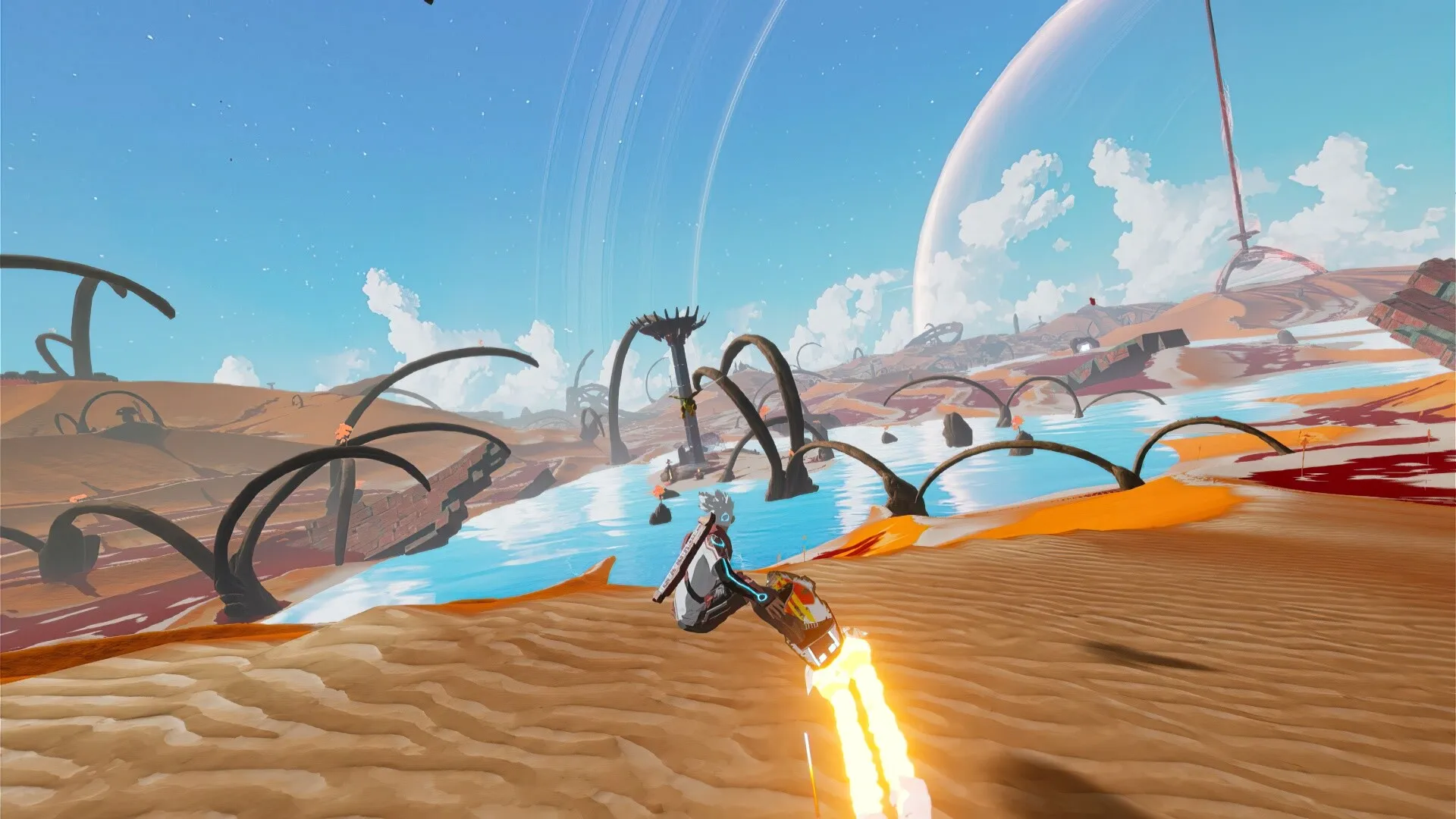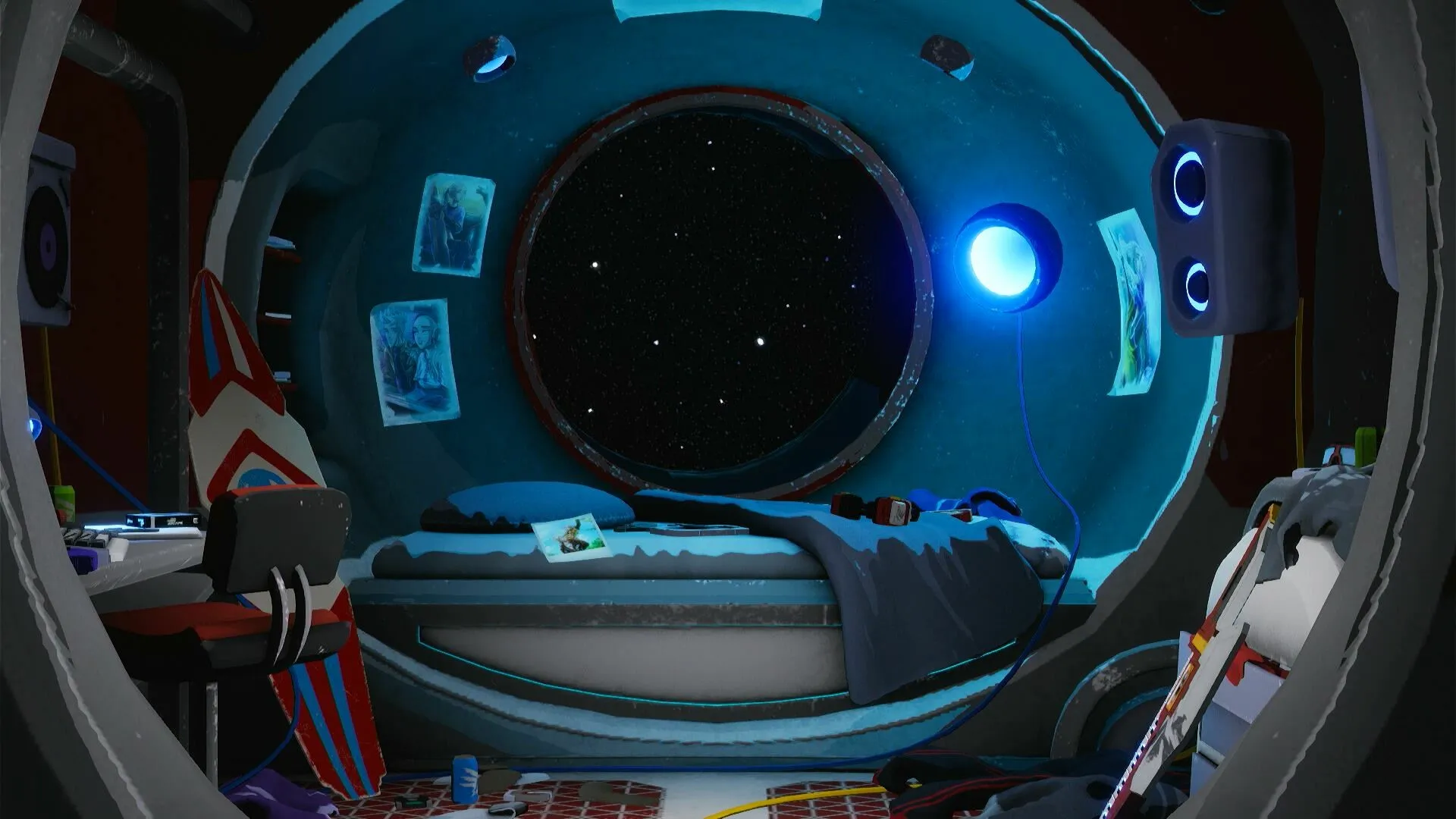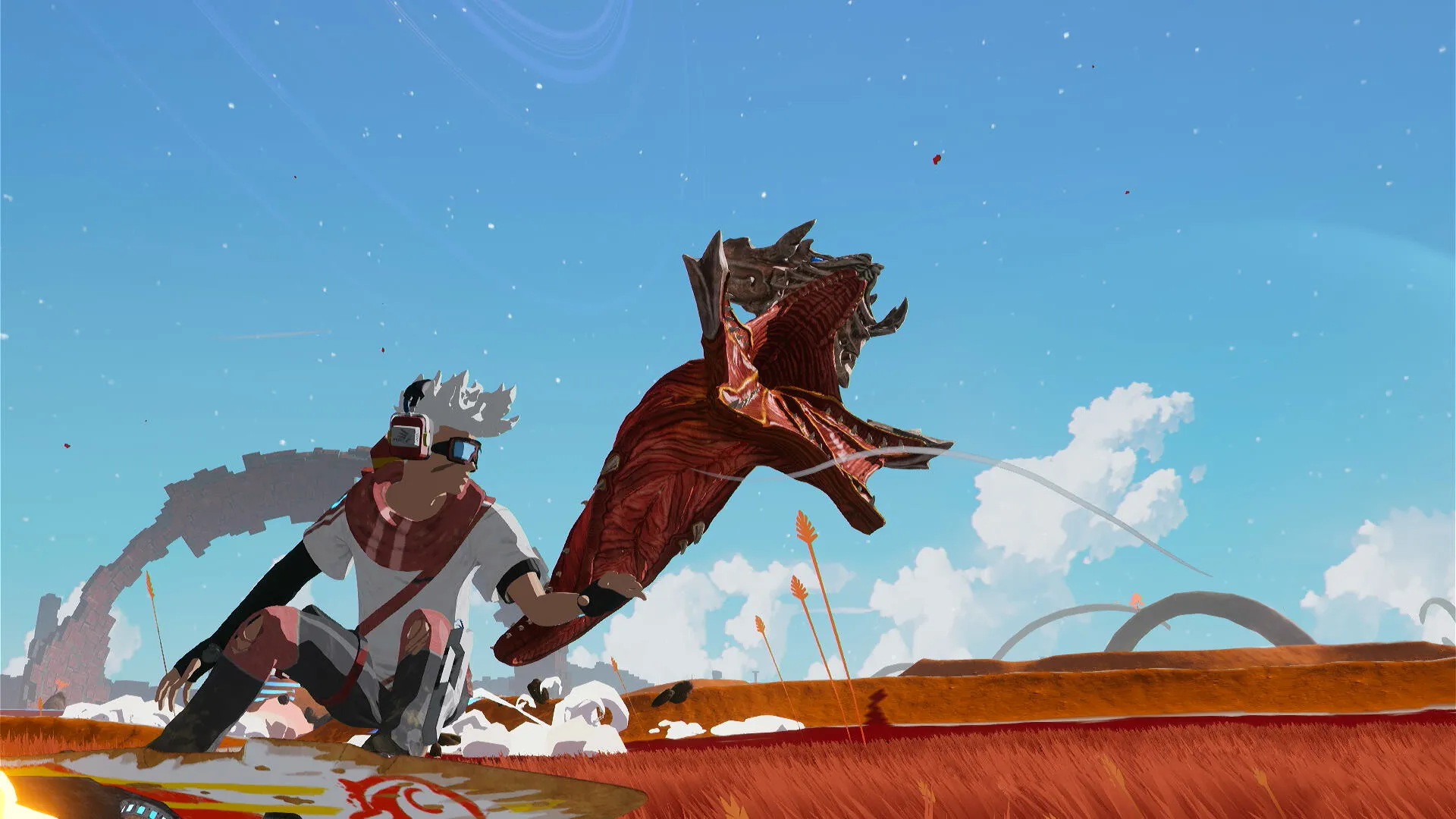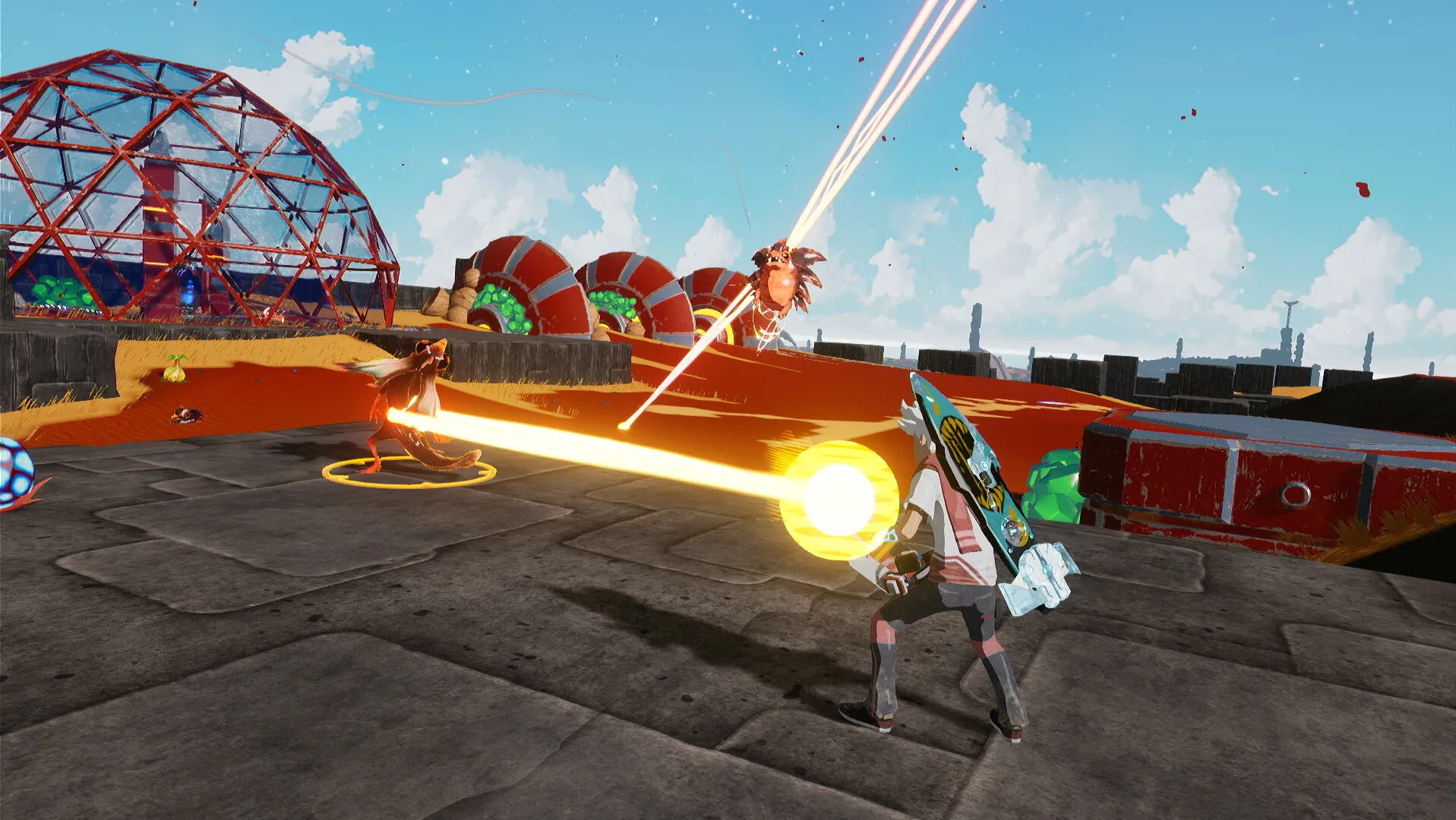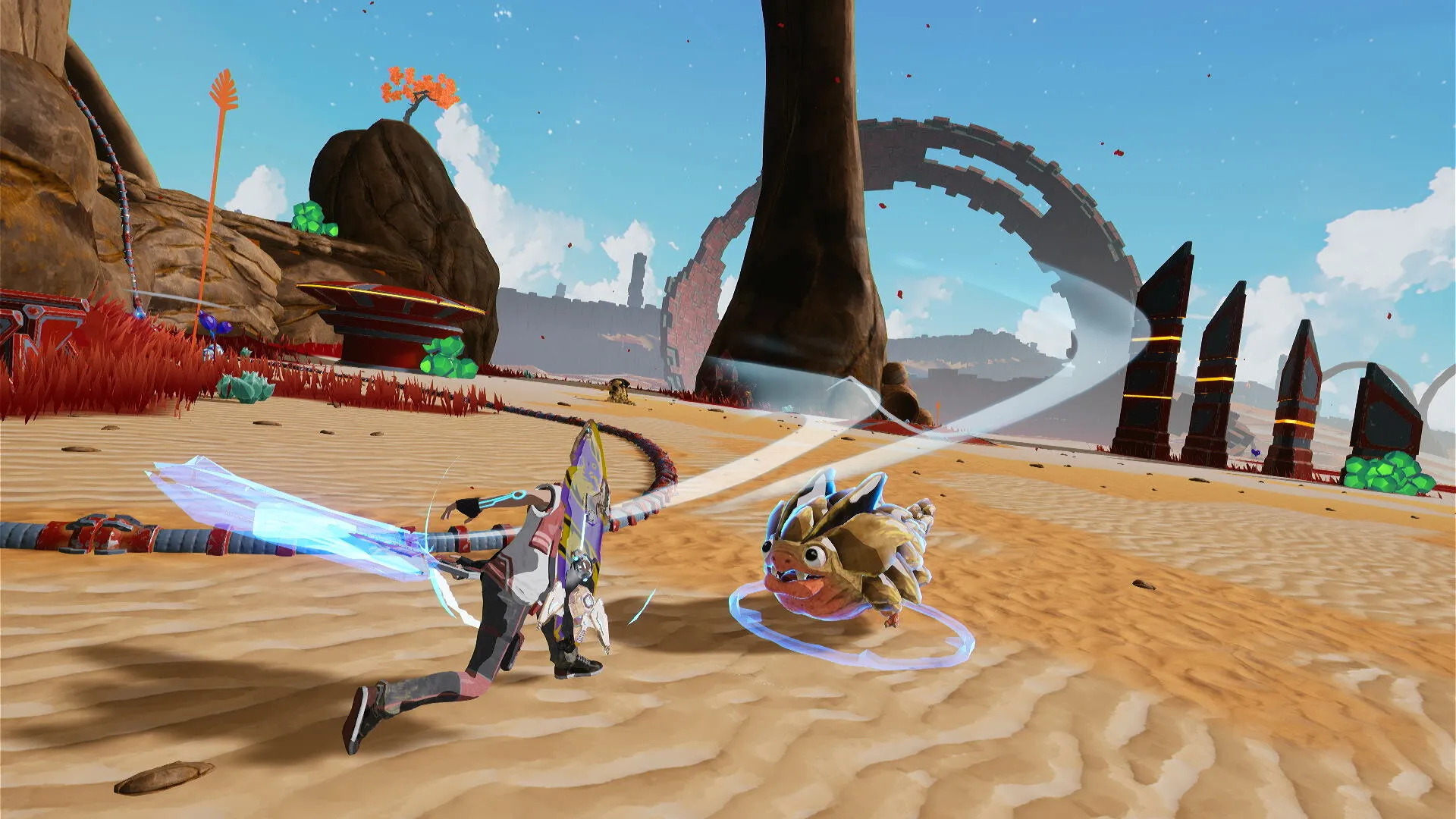BIOS finds himself stranded on the alien world of Cebete after an abrupt crash prompted by a desperate call for help. The character’s search for a missing colleague drives him through a setting filled with curious ruins and isolated outposts.
The game establishes its purpose early, as BIOS’s rescue mission sets the stage for encounters with enigmatic flora and hidden relics. His tool of choice—a Keytar—serves as a striking implement that unlocks new abilities and breaks barriers in combat and puzzle-solving.
Players experience a dynamic interplay between high-speed sequences on a futuristic hoverboard and reflective on-foot explorations. The board not only provides swift movement across pastel, otherworldly landscapes but also becomes a platform for performing energetic stunts. The combination of a musical instrument as a weapon and a travel mechanism introduces a fresh way to interact with the environment.
The open expanse of Cebete is filled with atmospheric mystery; scattered logs and subtle hints of a deeper narrative create moments of quiet reflection amid bursts of action. This creative choice in design invites both rapid thrills and occasional pauses, encouraging a balanced mix of excitement and contemplation that keeps players attentive and emotionally invested. What new experiences might arise as the story unfolds further?
Mechanics in Motion
The game offers a lively experience in its movement systems. The hoverboard stands out by delivering swift and responsive control that makes shifting between riding and brief on-foot action feel satisfying. The board lets players jump on or off with ease, promoting an active connection with the varied surroundings of desert plains, rocky plateaus, and sand ridges.
This freedom encourages creativity; players can use the board as both a quick means to cross vast expanses and as a tool to interact with the mysterious environment. During high-speed sequences, performing aerial maneuvers adds a refreshing level of excitement.
Executing a series of well-timed stunts brings extra speed and increased agility. The challenge is to master the rhythm of inputs, ensuring that each trick not only serves to speed across the terrain but also creates visually engaging sequences that enhance the experience.
The layout of the land itself plays a crucial role in how movement unfolds. Natural ramps formed by dunes and outcroppings invite players to build momentum, while open areas provide room for precise control adjustments. Transition moments—switching from rapid board sections to deliberate, walking phases—test players’ skill in handling diverse scenarios. These shifts influence how puzzles are approached and how encounters with adversaries are managed, urging players to adapt their style as the situation changes.
In addition, the game progressively introduces new mobility features. For instance, once players gain access to a hook-based swinging mechanism or jump pad, previously unreachable spots reveal themselves, rewarding persistence and experimentation.
This ongoing evolution of abilities pushes players to refine their techniques continually. The interplay between board mastery and controlled, calculated movement invites thoughtful experimentation, leaving space for creative solutions when obstacles arise. Could further improvements in control integration unlock even more inventive methods of traversing Cebete’s shifting terrain?
Battle Dynamics: The Keytar and Special Moves
The Keytar stands out as a remarkable instrument that combines combat function with auditory flair. Serving as the main melee option, its swing offers a rhythmic precision that synchronizes with each strike. The sound it produces as it cuts through the air adds a layer of satisfaction to each encounter, making every clash feel deliberate and impactful.
Its role extends beyond simple attacks, seamlessly linking with special skills that allow both offensive thrusts and defensive maneuvers. This integration adjusts the tempo of fights, letting players switch their tactics between fast-paced action and careful positioning.
Opponents appear in a wide range, from quick-footed attackers and agile flyers to hazards that employ elemental effects. Their designs require adjustments in strategy, urging players to time their parries and strikes with care. Encounters with larger adversaries, such as the imposing sand worms, provide memorable set-piece challenges. Players use the board tactically here, dodging heavy hits while positioning themselves for a counter-strike, which makes each boss battle a test of timing and resourcefulness.
The arsenal of special abilities unlocks further complexity. New skills—ranging from a force that shifts obstacles to bursts that slow nearby threats—create puzzle-like moments even during combat. Using these powers in synchronization with the Keytar can shift the balance in heated clashes. In some situations, switching skills during a fight forces players to experiment with unexpected combinations, often resulting in moments of genuine satisfaction when a well-timed maneuver turns a difficult encounter into a streamlined effort.
These layers encourage the player to refine techniques continually, turning each battle into a unique experience that rewards practice and creative approaches. What fresh tactics might emerge as players explore the synergy between their weapon and the evolving skill set?
World Impressions: Crafting Cebete’s Mystique
Cebete presents a setting that awakes curiosity with endless deserts, soft pastel horizons, and scattered structures that hint at forgotten eras. The planet is marked by mining sites, ancient ruins, and solitary towers that create a layered atmosphere.
Each area feels like a living scrapbook of a lost civilization, and the placement of these relics feeds a slow-reveal narrative embedded in the world itself. Audio recordings, scattered logs, and holographic messages encourage players to piece together fragments of history by simply exploring the land.
Interactive puzzle areas serve as focal points in the environment, arranged like shrines that challenge players to test their skill with newly acquired abilities. These chambers require timing and strategic use of environmental features to unlock further upgrades, additional moves, or hints about the hidden story.
The design of these puzzles grows along with the player’s progress, offering a mix of challenges that adjust as new powers are discovered. This measured difficulty ensures that overcoming each obstacle brings its own small satisfaction and unlocks more of Cebete’s lore.
There is also a strong incentive to search every corner of the landscape. Tower structures mark significant points on the map, with each climb expanding the visual reach and uncovering secrets tucked away in remote corners. Hidden items like collectible cassettes add moments of discovery that complement the unfolding backstory, encouraging thorough exploration.
Scattered lore elements paint pictures of a long-forgotten culture without overwhelming the explorer with excess information. The interplay of carefully placed environmental details and subtle narrative hints creates an experience where attentive players are quietly rewarded for their curiosity. What new revelations might surface as one continues to roam this enigmatic world?
Tailoring the Ride: Customization & Progression
Players have the opportunity to modify their hoverboard using a variety of materials found scattered across Cebete. Collectible organic and alien substances feed into an upgrade process that sharpens key abilities such as speed, agility, and sturdiness.
By merging these resources, adjustments to the board’s engine, booster, wings, plates, and bouncers allow for tangible differences in performance. Cosmetic options also prove functional, as treatments to the board help maintain its optimum condition.
The design of the resource system invites a careful balance between exploration and practical upgrades. Moving across expansive terrain may reveal valuable supplies, and decisions on how to allocate them test the player’s strategic planning.
While gathering materials can sometimes feel repetitive, it encourages a methodical approach to refining the hoverboard. Individual play styles benefit from customization that supports varied tactics in timed races and complex environments. This system underscores the importance of player choice and hands-on involvement with the game’s mechanics.
How might players use these modifications to craft strategies that redefine their experience on Cebete?
Color & Sound: The Atmosphere of Cebete
The game employs a crisp cel-shaded style that recalls comic illustrations, with soft pastel tones set against rugged deserts and imposing towers. High-speed board runs trigger fluid visual effects such as motion blurs and light trails, conveying the thrill of rapid movement.
On the audio side, a rock-inflected score supports the experience, while the Keytar’s resonant swings blend seamlessly with board sounds and ambient echoes. Hidden audio tapes reveal fresh tracks that provide welcome pauses amid bursts of action.
This careful mix of art and sound boosts immersion and shapes the emotional rhythm of each encounter. Every clash and quiet interval is threaded into a tapestry of sensory cues that amplify what unfolds on screen. What sonic surprises could emerge from the subtle interplay of light and sound in this thoughtfully constructed world?
Precision in Motion: Technical Execution & Controls
The control scheme for the hoverboard delivers a direct response that makes high-speed travel feel both effortless and satisfying. Maneuvering the board and chaining stunts require precision, and the input feels well-tuned for dynamic movement. Yet, there are occasional moments when executing aerial tricks demands a bit of extra attention, which may momentarily disrupt the otherwise seamless pace.
Shifting to on-foot exploration introduces a different set of challenges. The movement controls in these segments, structured on a tank-style system, sometimes hinder fluid action during combat scenarios. Camera adjustments can prove a little unyielding, making it necessary to manually fine-tune the view during skirmishes.
The camera generally tracks fast-paced board runs effectively, though there are instances of slight lag in intense sequences. Overall, the technical performance remains stable, supporting a consistent frame rate even during rapid transitions. How might further refinements improve the balance between intense action and precise control?
The Review
Star Overdrive
Star Overdrive delivers fluid hoverboard excitement and thoughtful narrative exploration amid occasional control challenges in on-foot segments. The creative integration of dynamic combat and immersive environmental storytelling impresses, while the art and audio design significantly enhance each encounter. Some pacing issues emerge in specific sections, yet the game remains a captivating showcase of inventive mechanics and well-realized world building.
PROS
- Fluid and responsive hoverboard controls
- Immersive narrative and layered environmental storytelling
- Innovative combat using the Keytar and special abilities
- Striking cel-shaded graphics paired with a rock-inflected soundtrack
- Dynamic world design that rewards exploration
CONS
- Occasional challenges with on-foot control precision
- Camera issues during intense combat sequences
- Repetitive resource gathering may feel grindy
- Pacing can be uneven in some game segments









































